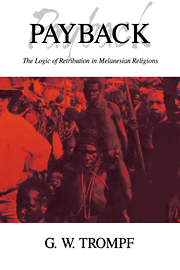Book contents
- Front Matter
- Contents
- Illustrations and tables
- Preface
- Abbreviations
- Preliminaries: The Theory of Retributive Logic
- Part One 'TRADITION'
- Part Two 'CARGO CULTISM'
- Chapter 4 Reprisal
- Chapter 5 Redemption
- Chapter 6 Wishing and Explaining the Extraordinary
- Part Three 'MODERNIZATION'
- Conclusions and Recommendations
- Bibliography
- Index of Melanesian Cultures
- General Index
Chapter 6 - Wishing and Explaining the Extraordinary
Published online by Cambridge University Press: 22 September 2009
- Front Matter
- Contents
- Illustrations and tables
- Preface
- Abbreviations
- Preliminaries: The Theory of Retributive Logic
- Part One 'TRADITION'
- Part Two 'CARGO CULTISM'
- Chapter 4 Reprisal
- Chapter 5 Redemption
- Chapter 6 Wishing and Explaining the Extraordinary
- Part Three 'MODERNIZATION'
- Conclusions and Recommendations
- Bibliography
- Index of Melanesian Cultures
- General Index
Summary
As in part I, space is needed to exemplify further how Melanesians have logically integrated and correlated the negative and positive faces of requital, and to do so in this second part by dealing with a so-called cargo cult. I have chosen the Pomio Kivung of New Britain, strong among the Mengen along the coast and hinterland on the north-eastern side of the island. As with the mountain Orokaiva Sangara (chapter 3), the choice is dictated by the availability of enough ethnographic data by which to analyse this integration, and to relate it to the reflective dimension of ‘cargo religion’.
I have detailed the historical background to ‘the Kivung’ (or ‘Movement’) in another place (1990b), and it suffices here to state that the Kivung emerged in a region experiencing relatively little interaction with the outside world until the Second World War. A Catholic mission was established near the important village of Malmal on Jacquinot Bay (from 1931), but the impact of its personnel—the Sacred Heart appointees being mainly Irish—was superficial. While the Christian God tended to replace the volcano deity, talk about Jesus got mixed in with stories of Nutu Ewalo, the younger brother/hero of Mengen myth, and concern to secure the support of the ancestors remained very intense (cf. Panoff 1968).
- Type
- Chapter
- Information
- PaybackThe Logic of Retribution in Melanesian Religions, pp. 259 - 282Publisher: Cambridge University PressPrint publication year: 1994



